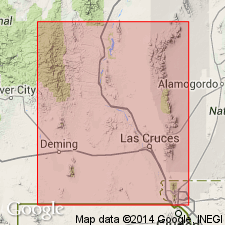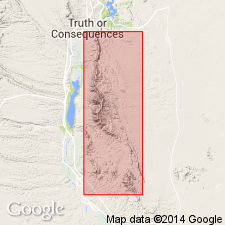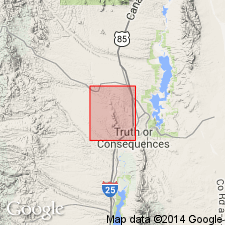
- Usage in publication:
-
- Red House formation
- Modifications:
-
- Named
- Dominant lithology:
-
- Limestone
- Shale
- Claystone
- AAPG geologic province:
-
- Orogrande basin
Summary:
Named as basal formation of Magdalena group for Red House Mountain where good exposures occur in several places. Type section measured at South Ridge, sec 10, T15S, R4W, Caballo Mountains, NM in Orogrande basin. Is younger than Lake Valley formation and older than Nakaye formation (new). Rests at various localities with erosional unconformity on: Lake Valley formation, Percha formation, Cutter formation (new), Upham dolomite (new), and Cable Canyon sandstone (a relief of about 500 ft). Consists mostly of thin-bedded limestone and shale or claystone with limestone nodules and lenses. Is gray to dark gray and usually slope-forming. Locally massive limestone beds that are commonly very cherty are present. A thin sandstone bed locally marks the base of the formation, and a coarse-grained, conglomeratic sandstone ledge is widely present in the northern part of mountains near the middle of the section. Many of the limestone and shale beds are abundantly fossiliferous. Is of Pennsylvanian age.
Source: GNU records (USGS DDS-6; Denver GNULEX).

- Usage in publication:
-
- Red House Formation*
- Modifications:
-
- Overview
- AAPG geologic province:
-
- Orogrande basin
Summary:
Name applied in the Caballo Mountains, south-central Sierra Co, NM, Orogrande basin, to the basal formation of the Magdalena Group above Ordovician rocks and beneath Nakaye Formation of Magdalena. Shown on correlation chart as equivalent to Sandia Formation of the Magdalena in northern San Andres Mountains and of Lead Camp Limestone in San Andres Canyon, eastern Sierra Co. Assigned a late Morrowan and early Atokan age. Authors speculate that Red House may not be a cartographic unit because its contacts were not well defined.
Source: GNU records (USGS DDS-6; Denver GNULEX).

- Usage in publication:
-
- Red House Formation*
- Modifications:
-
- Overview
- AAPG geologic province:
-
- Orogrande basin
Summary:
Magdalena Group in the Mud Springs Mountains of Sierra Co, NM in the Orogrande basin, divided into the (ascending): Red House, Nakaye, and Bar B Formations of Pennsylvanian age; and Bursum Formation of Early Permian age. The group unconformably overlies Upper Devonian Percha Shale in southern half of mountains and Upper Ordovician Cutter Dolomite of Montoya Group in northern half of mountains. The group underlies Lower Permian Abo Formation.
Source: GNU records (USGS DDS-6; Denver GNULEX).
For more information, please contact Nancy Stamm, Geologic Names Committee Secretary.
Asterisk (*) indicates published by U.S. Geological Survey authors.
"No current usage" (†) implies that a name has been abandoned or has fallen into disuse. Former usage and, if known, replacement name given in parentheses ( ).
Slash (/) indicates name conflicts with nomenclatural guidelines (CSN, 1933; ACSN, 1961, 1970; NACSN, 1983, 2005, 2021). May be explained within brackets ([ ]).

